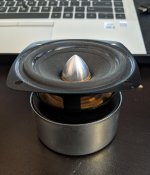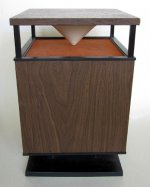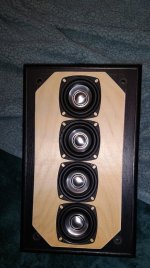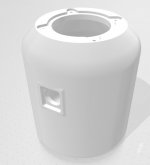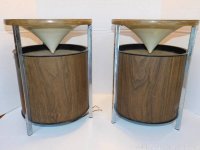I agree that completely ignoring those ranges is not the right way to approach the design. I have just found that attempting to get a single driver to do everything results in it doing everything mediocre or at the very least an obscenely large enclosure.
A pity that TTBOMK there's no longer a proper replacement for the vintage standalone mono/early stereo console's ~40-15 kHz 12" [no whizzer] and arguably the best 'full-range' voice reproduction single drivers to date.
FWIW, it was also the original W.E./Lansing 2-way monitor speaker's woofer and Les Paul's electric guitar's speaker, so while modern guitar drivers are a bit different spec-wise, an AlNiCo one rated 'loose'/'firm'/'smooth'/'smooth' would be my choice to EQ plus no need for a box and depending on the room/location, not even a baffle.
For a less 'focused' presentation, but still wide enough range, use W.E./Altec preferred 8" or 6" for a more rolled off male vocals.
I have a 4 x 3" that excels at voices, not much below 200hz.
Works great at 9', requires slight tilting, i though it would be more.
Sweet spot vertical around a foot.
Make sure the minimal frames are touching.
Works great at 9', requires slight tilting, i though it would be more.
Sweet spot vertical around a foot.
Make sure the minimal frames are touching.
I salvaged a couple of 3" drivers from an old Logitech 5.1 system that I may use to prototype and experiment with a few designs while I decide on something more final.
I really like the aesthetics of these Zenith speakers. I'm thinking they might be my target to design something towards
I really like the aesthetics of these Zenith speakers. I'm thinking they might be my target to design something towards
Attachments
In my experience you need something that is relative flat (+/- 6db roughly) in the vocal range, and that is from 75Hz to about 12-14kHz. For a good dispertion the driver may not be to big also.
A TB W4-1879 in a 6L sealed was what i used for a mono monitor for this before for someone who makes listening books with stories for (blind) kids, and she is very happy with that speaker. This has an F6 of 70Hz and is flat just to about 17kHz. At that time i was also looking at Mark Audio drivers, but they (at that time, 4 years ago) all had to much resonances in the higher regions or did not go low enough for a male voice (she and her husband do record it in their home). The TB does it right. I did include a class A amp board (in a seperate section at the back) that i bought on a french website so it was active and she could plug it direct in her soundcard with a volume knob.
A TB W4-1879 in a 6L sealed was what i used for a mono monitor for this before for someone who makes listening books with stories for (blind) kids, and she is very happy with that speaker. This has an F6 of 70Hz and is flat just to about 17kHz. At that time i was also looking at Mark Audio drivers, but they (at that time, 4 years ago) all had to much resonances in the higher regions or did not go low enough for a male voice (she and her husband do record it in their home). The TB does it right. I did include a class A amp board (in a seperate section at the back) that i bought on a french website so it was active and she could plug it direct in her soundcard with a volume knob.
https://www.kjfaudio.com/wp-content/uploads/2016/09/CHP-70_Gen.2_natural_Eng.pdf
I haven't heard these but maybe the bass is good enough? I would personally avoid anything that goes much above 5 to say 7KHz, you might get too much ssssss or zzzzzzz in spoken voice; some women's voices grate on my nerves when there is too much treble, sometimes the microphone is to blame...FWIW
I haven't heard these but maybe the bass is good enough? I would personally avoid anything that goes much above 5 to say 7KHz, you might get too much ssssss or zzzzzzz in spoken voice; some women's voices grate on my nerves when there is too much treble, sometimes the microphone is to blame...FWIW
How about Scan Discovery 10F or one of the less expensive Mark Audio choices?
Why bother with a cheap MA when the priciest equvilant (A5.2/3) is about half the price of the 10F. And better IMO.
dave
I was thinking the A5's won't go low enough in the bass and actually maybe too high in the treble for mostly spoken voice?
What about the CHP 70 gen 2?
What about the CHP 70 gen 2?
I use the CHP 70's in sealed 2.5 liter enclosures for my surround and atmos speakers in my home theater room. It has been a while since I've measured them but I want to say they had an F3 between 80-90hz.
Edit: My mistake, I actually have the CHR-70's
Edit: My mistake, I actually have the CHR-70's
Last edited:
CHP 70 gen 2
It does have a good midrange, top 2 octaves have purposely been shelved down which makes them sound a bit dark.
dave
CHR70 in 2.5 litre didn’t sound like it would work, but the sim shows a fairly nice bump at the bottom that will help balance the normally tipped up sonics.
At some point i may finally recover the 2 pair of CHR-70eN i have sitting in Lethbridge…
dave
At some point i may finally recover the 2 pair of CHR-70eN i have sitting in Lethbridge…
dave
Wide Imaging Stereo Speakers
There is an interesting story about Canon Wide Imaging Stereo Speakers. I think the first page is the most interesting:
Canon Audio (Part 1) – Music and Miscellany
Now you don't need to repeat what Canon did. You build the speaker for yourself and you can choose as high quality driver as you wish.
I'm thinking of doing some type of omni-directional or di-pole design where the speaker can be placed flexibly in a room and not have the listening sweet spot limited to a small location.
Anyone have ideas or suggestions to get me rolling on this idea?
There is an interesting story about Canon Wide Imaging Stereo Speakers. I think the first page is the most interesting:
Canon Audio (Part 1) – Music and Miscellany
Unfortunately however the electro-acoustic performance was compromised both by the difficulties of making the WIS concept work in terms of subjective tonal balance, and by an early commitment to using a relatively primitive full-range mid/HF driver. Despite the flaws however the first year of the S-50 and S-70 was commercially promising for the fledgling Canon Audio company with sales in the first few market territories going well despite relatively high retail prices.
Now you don't need to repeat what Canon did. You build the speaker for yourself and you can choose as high quality driver as you wish.
Look Ma, no boxes, just music.
I have two pair of FaitalPRO 3FE25 that have only two wires to the SS amps. I just keep moving them around the room using heavy blocks of maple as a tiny city scapes that bounces the sound around the room This is clear music, but no lows. It doesn't affect the charm of living in a changing environment. I am an old man and the strict, solid image of my young, expensive listening has wandered off and the wayward sound just yearns to wander, like a restless wind? I have the cermet (mud) magnets. The speakers were $20./each. Heresy? Those old Klipsch three ways I started with were never this charming. Loud, plenty of bass, but no dancing...
I have two pair of FaitalPRO 3FE25 that have only two wires to the SS amps. I just keep moving them around the room using heavy blocks of maple as a tiny city scapes that bounces the sound around the room This is clear music, but no lows. It doesn't affect the charm of living in a changing environment. I am an old man and the strict, solid image of my young, expensive listening has wandered off and the wayward sound just yearns to wander, like a restless wind? I have the cermet (mud) magnets. The speakers were $20./each. Heresy? Those old Klipsch three ways I started with were never this charming. Loud, plenty of bass, but no dancing...
I was thinking the A5's won't go low enough in the bass and actually maybe too high in the treble for mostly spoken voice?
What about the CHP 70 gen 2?
It's spoken word. A 150Hz cutoff would be fine.
Sure, some voices might loose a little bit of "weight", but they'll be perfectly understandable.
Chris
I will most probably soon print these (maybe some more improvement will be done on the baffle to round it a bit more). Just a hole for a 3FE22/25 and a speakon connector. I intend to print 3 or 4 of these to explore different options for exotic speaker placements around my living room, which is anything but audio friendly. No bass though, internal volume ca 1.3 - 1.5 l (need to measure when printed).
Attachments
I think this is the time for me to suggest what I did elsewhere.
Unfriendly room acoustic? Since quality audio in the conventional sense may be problematic, it may be worth you trying a Hafler variation, providing your amplifier can handle it. Have the regular stereo pair as usual, and add a third speaker 'behind' you with its binding posts wired to the positive terminals on the amplifier. It will reproduce the stereo difference signal (i.e. everything not common to both channels), and give you a reasonable stereo soundfield in a much wider range of seating positions. Strictly speaking it won't be accurate stereo in the usual sense, but if your room is screwing things up badly anyway this is less of an issue. It can also open things up on live recordings, ambient material etc.
You can run two rear speakers, which is actually the most common implementation -wire their negatives together, and the positives to the amplifier positive binding posts. Ideally you don't want to hear the rears as distinct sources; they should be at a lower level than the front channels.
Unfriendly room acoustic? Since quality audio in the conventional sense may be problematic, it may be worth you trying a Hafler variation, providing your amplifier can handle it. Have the regular stereo pair as usual, and add a third speaker 'behind' you with its binding posts wired to the positive terminals on the amplifier. It will reproduce the stereo difference signal (i.e. everything not common to both channels), and give you a reasonable stereo soundfield in a much wider range of seating positions. Strictly speaking it won't be accurate stereo in the usual sense, but if your room is screwing things up badly anyway this is less of an issue. It can also open things up on live recordings, ambient material etc.
You can run two rear speakers, which is actually the most common implementation -wire their negatives together, and the positives to the amplifier positive binding posts. Ideally you don't want to hear the rears as distinct sources; they should be at a lower level than the front channels.
Another thought. If you do point the drivers "up"; maybe a driver with a gently rising FR would be something to consider because you are way off axis here. You wouldn't want too much "brightness" though. As for the bass; I think the AT&T experiments with "True Voice" made the telephone band wider; 100 Hz to 4000 Hz. Some male voices go quite deep obviously but yes, 100 to 150 Hz will probably do. I mentioned the high end earlier also; too much on some female voices is very annoying and irritating to me anyway. One of the many projects I worked on in telecom was a conferencing bridge; we had one customer in particular; a lady with a high pitched voice. Some of pronunciations mimicked a tone we used to cancel a call. When she spoke; her formants, overtones, harmonics, whatever else literally would fool the system into a hang up. So, again, I would experiment with the highest frequencies; too much is just as bad as not enough.
I can pick up a pair of these for cheap locally.
The range of detail & quality of build & the driver used vary considerably. Each pair is a crapshoot.
I probably have some of the reflectors kicking around.
dave
- Home
- Loudspeakers
- Full Range
- Single driver design that excels in the human voice range
